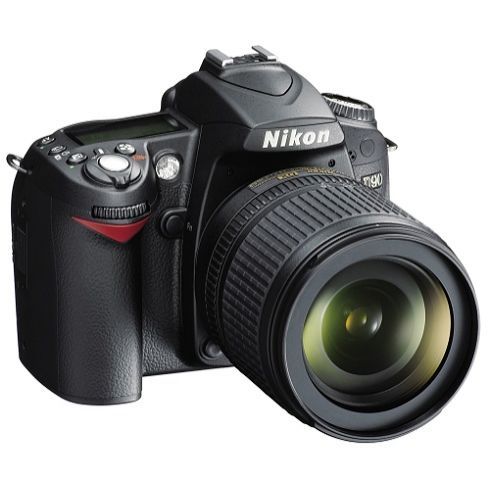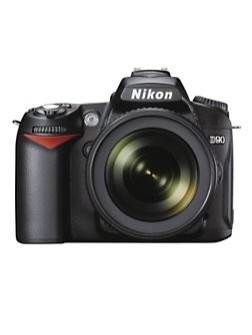Nikon D90 Digital SLRs
Nikon D90 Digital SLRs
|
[May 31, 2009]
starriderrick
Intermediate
Strength:
Dreamy CMOS sensor
Weakness:
Very slow auto focus in live-view
Bought the Nikon D90 in Jan.'09 as an upgrade to my much loved D80. Right out of the box I noted a major improvement in image sharpness. It’s unusually fast as well, able to fire numerous JPEGs in a single burst when using a fast SDHC card.I really like the new feature of 3D Focus Tracking in continuous autofocus mode for great reliability with action subjects.
Customer Service Not Needed Similar Products Used: D80 |
|
[Mar 22, 2009]
hoasjoe
Intermediate
Strength:
1. Large viewer. On the D70s found picture sharpness was occasionally a problem. At least with a large enough viewer you can see your pics well-enough beforehand so you can take the picture again until you get a good shot. Otherwise you enlarge it on the computer or TV later and found that it is a touch out of focus you missed the shot.
Weakness:
1. Certain buttons can only activate with the Live Preview off: the WB can be adjusted either way. After taking a shot you press the Play button or while taking the shot you wish to adjust your ISO your Preview must be off... otherwise won't work. A bit of inconvenience pressing an extra button.
Traded in an D70s for a D90. Was looking at the outgoing D80 but found that besides the higher mpix count, the other features were too close to the 70 so went with the newer 90.
Customer Service Not applicable... Similar Products Used: Nikon D70, Canon EOS Rebel |
|
[Mar 08, 2009]
José
Beginner
|
|
[Mar 03, 2009]
Derek Pell
Professional
Strength:
The Nikon D90 is one hell of a DSLR. When you consider that the image quality is comparable to the D300, then it’s clearly a smart choice for professionals who want to save a buck. It also makes an ideal choice as a backup camera. Factor in the D90’s ability to shoot 24 fps video and it’s a no-brainier for photojournalists. (Note: Canon jumped on the bandwagon, but Nikon was first.)
Weakness:
Video capacity is limited. No plug for an external mic. The D90 offers superb picture quality, and the ability to shoot short HD movie clips. It was the first D-SLR to offer video. But it's not a camcorder, too many limitations, but a nice, flexible model for photojournalists. |
|
[Jan 31, 2009]
jup1ter
Professional
Strength:
sharpness, colors, built quality, LCD, GPS, battery life, price (is in euros BTW)
Weakness:
1600+ iso, Brilliant machine
Customer Service Not very happy from Nikon After Sales (took 20 days to replace a lens!) |
|
[Jan 30, 2009]
Tony
Expert
Strength:
Image qaulity,ISO performance,Uses the D80 accessories, function buttons, size, feel, and overall design. Price seems on par for what you get and the performance of this unit. I would recommend this to anyone looking to jump into the SLR game, It a great camera and value.
Weakness:
Video mode, no AF, depending on the file size you are shooting the camera can heat up and shut off, though this is a safety built in, who wants their camera heating up. Honestly most of us who pay for camera liek this want to capture still images and not video.
I have had the D300 for almost a year,,,honestly I still prefer my D200 over that camera. I bought the D80 as a back up to my D200 and when Nikon released the 90 I decided to sell my D80 and replace it with the D90. I kept the vertical grip and placed it on the D90. My initial impression with this camera was it appeared to me that the image quality was slightly better than my D300, I placed my 18-200mm lens on this body and has been the only lens I have used on it thus far so everything is based on that combo.
Customer Service Have not had to use it Similar Products Used: D70,D80,D200,D300,FujiS3 |
|
[Dec 12, 2008]
Jim News
Professional
Strength:
Ease of use
Weakness:
Would like more frames per second
I’ve had my D90 for about a month now, with the packaged 18-105mm lense. I do a lot of news photos and for that purpose, this rig is rock solid in nearly all situations. The 105mm zoom gets you close and if not, the 12.3 mp is so clear, you can photoshop to get closer. Not my favorite method, so I generally carry a few lenses in my bag.
Similar Products Used: Fuji S2 Pro
|
|
[Dec 08, 2008]
Nikonman2
Professional
Strength:
Where do I start?.
Weakness:
Plastic body chassis.
This new Nikon is "BRILLIANT" what a step up into a new generation of digital imaging!.The improvements over previous models at this level and above are numerous and at a price point well below what you'd expect for this calibre of camera.
Customer Service Never needed it in over 20 years of using Nikon equipment. Similar Products Used: D200. |
|
[Oct 25, 2008]
sfpeter
Intermediate
Strength:
Improved high ISO performance over the D300.
Weakness:
Aside from the movie mode it's another DX Nikon.
The D90 is a mixed bird. Market wise it replaces the D80, yet offers slightly better image quality than the D300. In many ways it's a step ahead, and is the first DSLR on the market to offer a movie mode.
Customer Service Have not used Similar Products Used: D50, D700, D200 |
|
[Sep 15, 2008]
Marshall
Professional
Strength:
The strengths are many:
Weakness:
1. Only 5 minutes segments of Hi-def video if you see Bigfoot.
I bought the D90 kit to replace my D80 at weddings. Yes, I'm a wedding photographer. So why would a pro, who can write off any camera in his taxes, settle for a mid-grade camera? Size, weight, feel, and reasonable costs on accessories (MB-D80 battery pack is half the price of the one for the D300)! Prosumer cameras also seem to have far more usable whistles and bells.
Customer Service I emailed Nikon with a question about custom menus, and they answered back in a few hours, on a Saturday! Thanks Nikon! Similar Products Used: Nikon D50
|




















